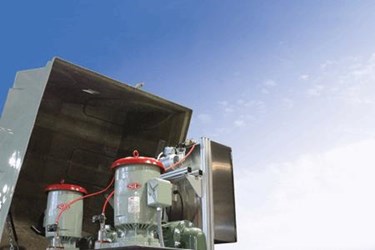A Pumping Primer — Considerations For Prime-Assisted Wastewater Pump Stations

Prime-assisted wastewater pump stations that house all mechanical and electrical components above-grade are a safe and cost-saving alternative to traditional or chopper submersibles, addressing confined space restrictions and improving operating efficiency and reliability.
Naturally, placing the pumping system above the wet well with the pump rotating assemblies above the liquid level — rather than submerging with submersible pumps — requires priming assistance. The liquid has to be lifted in order to “prime the pump” and commence safe pumping. There are two general ways that this occurs in centrifugal pump design: fluid suction-lift achieved with self-priming pumps and fluid suction-lift achieved with vacuum-priming.
Self-priming pumps are typically horizontal end-suction centrifugal pumps that “self-prime” by using internal recirculation within the pump in order to draw the liquid. After water fills the volute, the pump’s impeller will turn in a counterclockwise rotation. The initial prime of the pump is directed through an ever-increasing water channel into a discharge chamber inside the volute casing. There, the water and air separate. The heavy water falls back down into a recirculation port while the air is evacuated. While water recirculation occurs inside the casing and air is being released, low pressure is created at the eye of the pump impeller. The higher atmospheric pressure differential forces the liquid to rise up the suction pipe and pushes all of the air ahead of it into the volute casing where it is handled through the recirculation process. As the water arrives, the pump goes into complete operation. Overall, the priming stage can take several minutes from the beginning before full pumping commences.
Vacuum primed pumping systems differ significantly from self-priming type pumps. First, where horizontally-configured self-priming pumps are designed to prime and pump, vacuum primed pumps are vertical, close-coupled pumps with oversized pump shafts and bearings. Rather than priming itself, these pumps rely upon a simple, ancillary priming system, comprising three basic components: a prime sensor, a solenoid valve and a separate 1/8 Hp vacuum pump. When the liquid level rises and tilts the low-level displacement switch or transducer, the vacuum pump is activated in order to lift the liquid into the volute casing. The vacuum pump turns off when the prime sensor senses sufficient liquid in the volute. The centrifugal pump activates once primed and commences pumping. From a totally non-primed condition, the system primes the pump within 60 seconds under standard rated conditions. Once the centrifugal pump is primed, it is designed to stay primed indefinitely.
Despite being separate from the actual centrifugal pump and requiring a separate vacuum pump, the vacuum priming process is generally more efficient than self-priming because the self-priming pump motor must generate the priming action. For example, a 15 Hp self-priming pump may utilize 5 Hp simply for the priming cycle compared to just 1/8 Hp of the vacuum pump. Thus, the need for self-primers to both prime and pump increases the energy required to prime while lowering the overall operating efficiency. Compared to vacuum-primed pumps, the overall difference in wire-to-water efficiency can be as much as 20-25 percent, which can mean hundreds to thousands of dollars per pump station in annual savings when compared side-by-side.
In evaluation of prime-assisted pumping systems, whether vacuum-primed or self-priming, there are several things to consider: pump efficiency/power costs, operator safety, O&M time and cost including downtime, equipment durability, ease of access to pump internals. When undertaking an evaluation, planners should consider and explore answers to these questions:
1) Pump Efficiency/ Power Costs: At normal operating conditions, what are the differences in wire-to-water efficiencies for the particular application between a self-priming pump and vacuum-primed pump? How much does that translate into annual power costs? Evaluating the application’s design points along the particular pump’s published pump curves can provide the data for calculating the pump efficiency and resulting power requirements in a given period of time.
2) Priming System Nuances: What are the components that comprise the system’s priming scheme? What are events that can prevent normal priming? How will typical priming time affect the wet well size? For example, if one system takes several more minutes to prime than another, it can affect the wet well volume capacity. It would need to be sized correctly to prevent potential overflows during heavy surges in flow.
3) Maintenance: What are the wearing parts that will have to be eventually replaced (at what costs)? Are there shims, v-belts (belt-drives), or wear plates that have to be adjusted? Seal maintenance: Does the pump require fresh-water or oil-filled seals (that require periodic checking and filling)? How many different kinds of valves are required for each system? When performing maintenance on these kinds of pumps, how easy is it to gain access to the volute and seal? These are important questions for assessing long-term O&M and life-cycle costs. Obviously, maintaining fewer wearing parts lowers labor time and associated costs. The better pumping system manufacturers will be able to provide real data on parts and maintenance labor.
4) Operator Safety: What operator safety concerns apply beyond typical electrical shut-off procedures? For example, when accessing the volute, are there any issues with potential spillage or steaming concerns (generated from recirculation)? Specifiers and decision-makers should understand the differences in vertical and horizontal pump construction as it relates to maintenance. Overall, because confined-space requirements are eliminated, prime-assisted pump stations do provide the safest approach to wastewater pumping for flows of at least 50 gpm compared to conventional submersible and chopper pumps.
5) Footprint: Because prime-assisted pump stations are above-grade, all of the equipment will be housed on a skid or steel base with different types of enclosure designs. Obviously the location of the sump must be able to provide the vertical or horizontal access space in order to access the equipment. That said, there are no confined space entry requirements and valve-vaults to consider.
